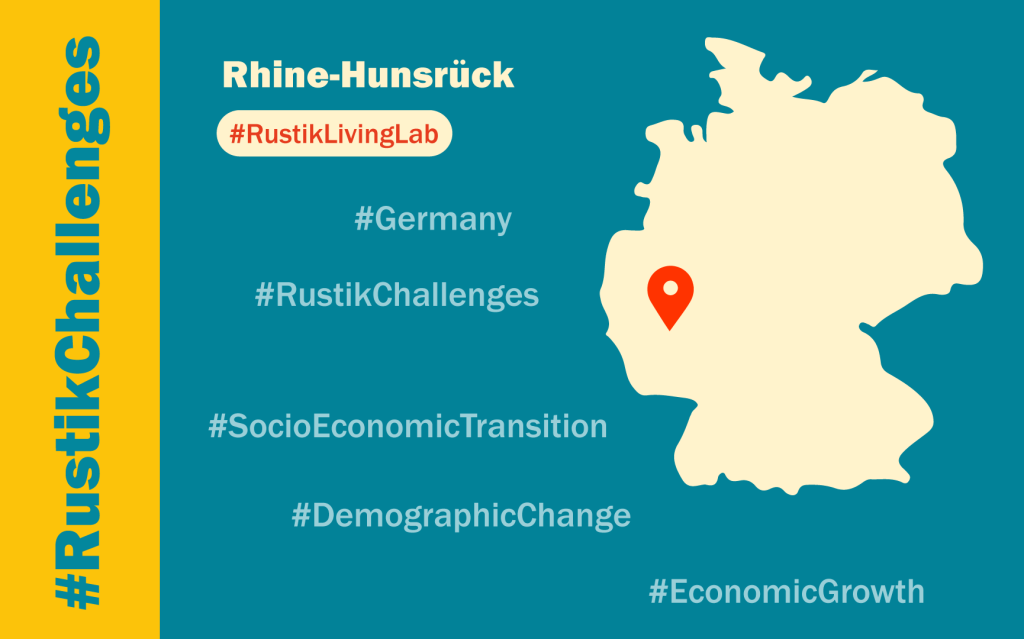Rhein-Hunsrück, Germany
Key Facts
Located in the federal state of Rhineland-Palatinate, the Rhein-Hunsrück district lies between Luxembourg and the metropolitan area of Frankfurt. It reaches from the Upper Middle Rhine Valley as its eastern border to the Hunsrück upland in the west. With its 103 700 inhabitants and only three towns between 5 000 and 20 000, the region is sparsely populated and rural in character. Traditionally, forestry has been an important branch of local economy, especially in the uplands. Today, the Rhein-Hunsrück district hosts mainly small and medium sized businesses. Relevant branches with regard to employment are manufacturing, processing and construction industries, handicrafts, public service and education, as well as trade and tourism. During the last decade, population development has been stable and is expected to decrease only very slightly in the next two decades, while ageing in general. Since 2018, the region produces more renewable energy (mainly wind and solar) than it consumes, taking up the role of a best practice example in terms of local energy self-sufficiency.
Living Lab transitions
The Rhein-Hunsrück region is confronted with challenges of demographic change. This has effects on the workforce and hence regional value creation. A shortage of skilled workers is already evident in some occupational groups and is presenting employers with rising challenges to close these gaps. The decrease is a result of the above-average economic growth compared to the rest of Germany and the resulting higher demand for skilled workers in the past two decades, as well as the outflow of young people for academic training. This not only affects academic specialists in individual occupational groups, but above all non-academic specialists in technical occupations, e.g. in the fields of mechatronics, automation technology and electrical engineering. There are also shortages of skilled workers in health and care professions. The commuter ratio is negative. However, there is an increased employment rate in many sectors, including manufacturing, services, financial, insurance/business services, real estate and public, education and health services. As the Rhein-Hunsrück district has the highest job density of all districts in Rhineland-Palatinate, it is one central goal of regional development to attract people to move or return to the region.
The Rhein-Hunsrück district is largely located in the area of the LAG Hunsrück, which has been adressing these issues through LEADER Local integrated rural development strategy (short: LILE) for years. In accordance with the strategy’s title ‘Sustainable Region’, the strategy focusses on further improving the quality of life, sustainable development of the regional economy and the preservation of cultural diversity. In addition, greater attention is paid to children and youngsters as well as volunteers. Innovation plays a crucial role in the LAG strategy, which has led to the fostering of regional economic activities.
The other part of the region belongs to the LAG World Heritage Upper Middle Rhine Valley. Its strategy provides for sustainable development as a living space for all generations. The strategy’s goal is to make the region more attractive and to protect and sustainably develop the cultural landscape. The aim is also to enhance regional identity.
The Hunsrück region hosts a unique recreational area, in which parts of the Soonwald-Nahe and Saar-Hunsrück nature parks are located. The region is also home to numerous culturally and historically significant testimonies from the time of the Celts and Romans, which attest to the common historical development of the region and which are still seen as connecting and identity-forming. The Middle Rhine Valley is well known for an ancient cultural landscape, characterised by small towns on the river banks, the steep slopes with their vineyards and the numerous castles and ruins. The Rhine river itself is on the one hand Europe’s most important waterway, and on the other hand a source of common regional and even German identity. Furthermore, the territory has a well-preserved cultural landscape with rich stands of orchards, cattle pastures, field margins and groves, which give the region a special attractiveness. In addition, the numerous contiguous forest, meadow and arable land areas provide habitats for extensive wildlife populations. Extensive parts of the region are protected areas.
Conflict potentials arise from a coexistence of agriculture and nature conservation. Moreover, the region is not omitted from the effects of climate change on agriculture and forests as well as the Rhine. While environmental protection and addressing climate change are only tangentially addressed through the LILE, the Rhein-Hunsrück district has had a climate protection concept since 2011 that focuses on energy production, efficiency and saving. Today the area produces more than 300 % of its own energy needs through renewables (mostly wind and solar, but also biogas), making the region a pioneer in the energy transition.
Access to high-speed Internet in the Rhein-Hunsrück district currently lags behind the national average. However, the expansion of the fibre optic network in the region is progressing supported by public funding from the state and federal government.
Pictures 📸







